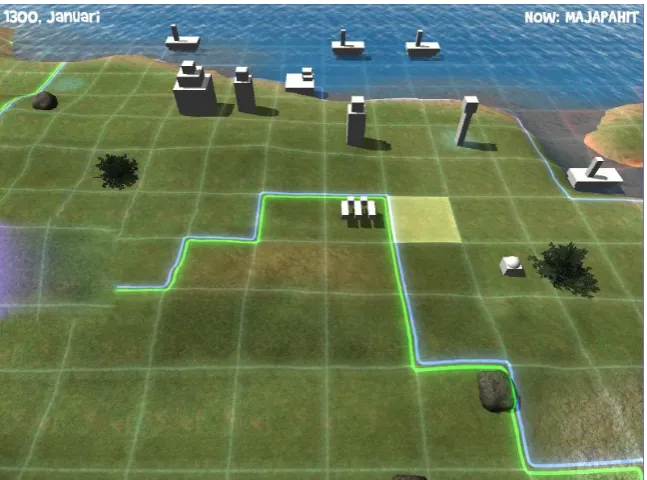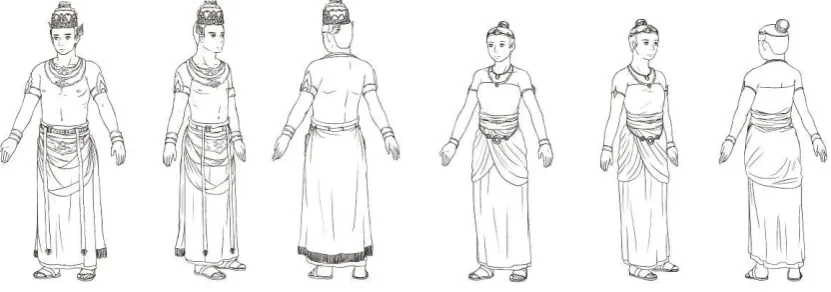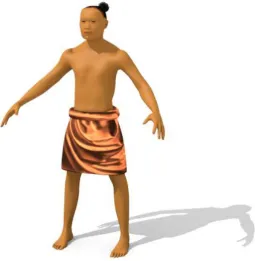Designing Computer Simulation Game for Learning the History of the Kingdom of Majapahit
Erandaru
1, Liliana
2, Silvia Rostianingsih
31
The ubiquity of computers and its rapid technological development in the form of computer games has provide an alternative media to build student’s interest in history by providing players with intriguing facts presented as a narrative merged within the gameplay. It engages student with imaginative virtual world as well as the simulation of real-world environments and hypothetical situations. However its use in classroom is limited, as the method use is not ideal within the available time-frame of a formal education system. Within this constraint, computer game as a learning tool could only be applied beyond the classroom. Although not ideal if meant as an inseparable part of a learning module, it still provides a valuable contribution to the whole system by coaxing student to voluntarily add their allocation of study time through the act of multitasking (learning while playing), not to mention also increasing their interest in the learned topics.
A virtual reconstruction of the kingdom visual environment based on archaeological study will provide student with a more scientifically accurate representation of Majapahit. Providing a valid references for studying through the act of observing. The gameplay will provide students with scenarios based on real historical events, enabling them to interactively learn through experimenting with possible actions to solve a problem, analyzing the resulting outcome and founding the relationship between cause, action and outcome. The game will increase student knowledge beyond the classroom, providing more quality time for a teacher and students discussion of the topic’s meaning and its significance for modern day Indonesia.
Keywords: e-Learning, Simulation Game, History, Majapahit.
1
INTRODUCTION
Since 2013 the Indonesian Ministry of Education and Culture endorse implementation of new learning techniques in primary education to meet the rapid technology development and change in life style. Those that encourages student to search for information from various resources, capable of identifying problem, rehearse analytical thinking and understand the importance of network and collaboration in problem solving [8]. E-learning has become one of the model of learning encouraged to meet those needs.
Education game as part of e-learning tools has yet to be implemented within the curriculum. However various researches and experiments has already been instigated to understand and explore possible approaches in implementing education game as part of the curriculum. This cautious approach is of no surprise as most academia are still adapting to the paradigm shift in the relationship between game (in this case video or computer games) and education.
This paper covers part of our research project in designing game for learning history. The course subjects for our research topics is the history of Majapahit, a 13th-14th century kingdom in Java considered by archaeologist the pinnacle of classic Javanese culture. Majapahit holds significant meaning for Indonesia as a country as it provides historical references of the country territorial regions. It also give the country its national motto “Bhinneka Tunggal Ika” meaning unity in diversity.
2
COMPUTER GAME AS LEARNING TOOL
According to Gentile, the impact of video game in society is still a much debated issue. One school of thought considers video game simply as a means of entertainment, excessive usage may interfere with productivity. This opinion puts video games as a neutral medium in which the impact can be positive or negative depending on the usage factor. Another opinion is that the impact is positive or negative depends on the content and gameplay. Research indicates that elements of gameplay with excessive violence and/or distortion in the representation of gender can affect the behavior of players, especially at early age. Regardless of the pros and cons, video or computer games could be used in education if, according to Gentile, the gameplay is designed for learning purposes [5].
Gee observed that commercially successful video games has gameplay with a high degree of difficulty [4]. To be able to finish the game the player must analyze the challenges, devise a strategy, test and implement these strategies in action and draw conclusions from the failure or success of such action. The process will be repeated throughout the game until the game is complete or achieve the ultimate goal. Activity of players in the game play has similarities with experience-based learning model.
Gee added that commercial success is also influenced by the ability of the game to be studied. In other words, despite having a high difficulty level, the game still gives "room" for players to learn how to overcome these difficulties. More interesting Gee observes that the players are willing to do the learning process in a long duration (can take hours) is voluntary and does not look bored. Gee argues that the learning methods used by successful games in the context of formal education with the argument that the game managed to attract players to learn. Based on the aforementioned research Gee argues that the learning model used by the game can be applied to a model of learning in formal education.
Gee analysis of the game shows that there are 5 basic principles that can be used as an implementation framework as follows: active and creative learning, design learning, semiotic learning, semiotic domains and learning metalevel thinking of semiotic domains. Video games that are commercially successful apply those five principles in the design elements of the game.
The theory proposed above still has some problems in its application. From a gameplay perspective Francis [3] recorded several constraints that can be identified into 2 major problems. The first is learning using commercial games is difficult to be integrated in classroom activities than educational games because of time constraints on the formal education system. Commercial games are not designed to be played within the time duration of 50 minutes to 1 hour (standard duration of 1 credit in the classroom learning system). The second is that learning process in commercial games do not provide a means for players to reflect on the activities that have been performed as part of the topic of learning in the classroom. Players are too focused on play activities that they take less attention to the possibility of implementing solutions within the game for facing challenges in the real world.
Francis offers 4 models for game-based learning system application in the formal education system as follows: situated learning in virtual environment, overt instructions and reflective discussions, practical media production; and critical framing. All four models are expected to enable the application of learning-based learning system within the scope of the class game.
This design project uses five basic principles of the learning model as Gee offered as a guide in the design elements of the game. While Francis models will be integrated as part of the gameplay to keep the game relevance in its application in the formal education system.
3
METHODOLOGY
The first stage aims to create a visual reconstruction of Majapahit based on archaeological findings and studies. Physical features, fashion style and gesture from Majapahit era are reproduced visually using references from artefacts, relief, relics, literature and inscription found on archaeological sites and interviews. Since source of reference is rarely found intact, subjective interpretation are introduced within certain degrees. The first stage of this project involved undergraduate students as visual artist. The goal is to document their subjective interpretation of Majapahit. It will provide insights of Majapahit from their age group.
visual pattern should help players to understand the conveyed information as well as associate it with Majapahit.
The main problem in presenting visual information related to the topic is time. Majapahit exist only in the past. Its history is an interpretation from fragments of information from relics, historical records, artifacts, architecture and literature. So far there has yet to been found any document that provides a complete historical records of Majapahit.
According to Benjamin authenticity can only be achieved within the same time scope and space [2]. This means that theoretically the player will never be able to truly experience the kingdom of Majapahit. The time difference does not allow players to associate visual information obtained from the game with experience from the past, since she has never experienced those past events before, thus emotional attachment will never be formed. However the game could provide audio and visual stimuli to recall past experience and emotions, although having no correlation at all with the game topic, could create an idea of past events that the player could relate to. The crucial factor is guiding players’ perception to remain relevant with historical facts.
4
CONCEPT & DESIGN
4.1 Game Genre, Narrative & Gameplay
The game genre is a combination of education and strategy game. Education in that the game purposes is to intrigued player interest in learning the history of Majapahit. Strategy in that the game requires players to engage with problems that forced them to analyze the condition and finding the possible solution based on those analysis.
The narrative of this game is based on the history of Majapahit from the founding of the kingdom in 1292 until the civil war of Paregreg that marks its decline [7]. The dramatic structure of the narrative is divided into 3 stages, the beginning, golden era and the fall of Majapahit. Each stage marks an important event in Majapahit history. The beginning stage span from the year 1292 AD to 1319 AD. Golden Era stage span from the year 1320 AD to 1389 AD. The fall stage span from the year 1390 AD to 1406 AD.
The game is designed for single player. Player will face the game’s artificial intelligent (AI) algorithm as opponent. This is a turn-based game, meaning player will take turn with the computer for each action. Each turn represents a certain amount unit of time (year) based on the history narrative of Majapahit.
Figure 1. A preliminary prototype for testing gameplay
The first stage requires map of the region displayed from a distance to provide player with clear view of the region, location of opponents and area of interest. The requirement could be achieved by simplifying map’s details and using icons to represent objects that otherwise are too small to visually reproduced using correct scale.
The second level of play would bring the player into the battle ground. This level decides if player could conquer an area from the first level through military conquest or if the player could defend an area from military attack. Thus this level is only available if player decided to use military action to conquer an area in the global map. The goal is to defeat the opposing force. This level also used turn-based system, player take turn with computer to perform action. The challenge is to arrange soldiers strategically based on each soldier’s strength and weakness compared to that of the opposing force. As in the first level, the type of battle ground and the characteristic of soldiers from the opposing force is based on historical records. Player wins this level when she managed to destroy all the soldier from the opposing force.
The second level requires a detailed representation of game characters as well as physical environment. The second level is currently under development. Until the writing of this paper we are still in the progress of developing 3D model and animation of game characters and environments.
4.2 Game Characters
Characters are classified into 2 large groups based on their role within the narrative and gameplay aspect of the game. Within the narrative group characters are divided into 2 sub-groups, while gameplay is divided into 2 sub-groups.
The first group based on narrative classification is the main characters. This group consists of real and fictional character that holds an important part to maintain narrative flow. They could either be protagonist or antagonist character. Details on visual representation, voice and motion are important to emphasize characterization.
The second group is the supporting characters. This group does not affect narrative flow but needs to be visually present as part of the narrative stage. Supporting characters consists of the religious group (monks), military group (foot soldiers, archers and mounted soldiers), civil servant (tax collector, village’s head), merchants, commoners and foreigners (Persians and Chinese). Included also within the supporting characters are various animals present at the time (pets, domesticated or wild) [9].
NPCs’ actions and motions is controlled by the game artificial intelligence (AI) algorithm. Compared to playable characters, NPC is more varied in character. While playable characters are mostly soldiers, NPC could be a monk, commoner, foreigner, merchant, civil servant, soldier, main character and animal. Each NPC requires different pose and sequence of animation.
Visual appearance for characters is based on archaeological studies [6] of visual representation found in carvings, relief, statues as well written description found in historical records. Distinction is shown through the character’s clothing as shown in the following examples.
Figure 2. Visual representation of commoners (illustration by Jane Marsha)
Figure 3. Visual representation of soldiers (illustration by Jane Marsha)
Figure 4. Visual representation of royalty (illustration by Jane Marsha)
logical reference we searched for archived of Javanese in old photographs. These photographs provide a generic facial features (figure 5) that could be used for the game character 3D model (figure 6).
Figure 5. Generic facial features for game characters
Figure 6. 3D model for game characters
4.3 Game Environments
Game environment is classified into 2 groups. The first is nature, visual and sound environment that are not man made (e.g. plants, water body, sky, mountains, etc.). The second group is man-made environment. This consists of buildings that serves either as dwellings, temples, monuments, fortifications, infrastructures or entertainments.
Visual and audio reproduction of nature environment is based on the geographic conditions of present day Trowulan. We believe that there are no major changes in the landscape since Majapahit until present day. As for the man-made environment, visual reproduction is based on archaeological research. The kingdom and capitol of Majapahit boundaries is based on analysis of historical records and archaeological findings [1]. While buildings is based on its visual representation on carvings, renovated ruins and traditional buildings that still exist in the island of Bali.
found on carvings. Temples is based on renovated ruins, while palaces is based on architectural design of traditional buildings in Bali.
Figure 7. A replica of a commoner’s house based on old Majapahit architectural style.
Figure 8. A family housing complex from lower class (left, illustration by Stephanie) and upper class (right, illustration by Novita).
5
CONCLUSION
Computer game is a promising media to learn about the history of past civilization. The lack of a complete and objective historical records of the past forces historian to fill the remaining gap using assumption to form a hypothesis to understand what the culture was. There is no absolute truth as conclusion of each study will change from time to time according to recent archaeological findings and the development of new methods. Computer game has the ability to virtually reconstruct physical environment from otherwise lost civilization and to simulate past events. It could provide a tool for students to challenge the known conception about Majapahit through the act of experimenting and observing.
Virtual reconstructions of physical objects could help students visually experience the environment of Majapahit. It will help them engage with the history of Majapahit by observing directly the simulated environment and events of the past. It will provide students with different perspective of Majapahit compare to those dictated by course book. This new perspective will provide student a part in the authorship of Majapahit history. Hopefully it will intrigue students to find out more about Majapahit.
Narrative is an important part of this game. It is used to transform historic facts into a story. It gives dramatization to otherwise a list of facts. It helps players to make sense the relationship from one event to another and grabs players’ attention and curiosity, forcing them the follow the story until the end. Narrative also supports the gameplay, by providing player with reason for an action. Without narrative player will focus only on skills (such as in arcade game) to reach the defined goals. Their motivation is only to reach the highest score or to be the strongest player. Narrative helps players to relate with the characters when facing with the posed problems, giving the player the opportunity to question “what could I do” rather than “what should I do”, guiding player to constantly be critical and have the ability to analyse in order to solve a problem.
However promising the media is for learning history it is still difficult to implement effectively within the formal education system. Because it rely on emotional approach it will be difficult to implement within the mechanized structure of our formal education system. Further research on this matter should be made to find a solution for implementing this media within the formal education system.
REFERENCES
[1] Adrisijanti, Inajati. Majapahit Batas Kota dan Jejak-jejak Kejayaan. Balai Arkeologi Yogyakarta. 2012
[2] Benjamin, Walter. The Work of Art in the Age of Its Technological Reproducibility and Other Writings on Media. The Belknap Press of Harvard University Press. 2008.
[3] Francis, Russell. "Towards a Theory of a Game Based Pedagogy." JISC Innovation Learning 2006: Transforming Learning Experiences. 2006.
[4] Gee, James Paul. What Video Games Have to Teach Us About Learning and Literacy. New York: Palgrave MacMillan. 2003.
[5] Gentile, Douglas A. "Video Games Affect the Brain - for Better and Worse." 23 July 2009. Dana Foundation. 20 April 2013 <http://www.dana.org/news/cerebrum/detail.aspx?id=22800>. 2013.
[6] Lelono, Hari. Pakaian dan Stratifikasi Sosial Masa Klasik di Jawa Timur (Kajian Relief di Candi Rimbi, Jawi, Kendalisodo, dan Museum Trowulan. Berita Penelitian Arkeologi. Balai Arkeologi Yogyakarta. 1999.
[7] Munandar, Agus A. Ibukota Majapahit, Masa Jaya dan Pencapaiannya. Komunitas Bambu. 2008.
[8] Sisdiknas. Pergeseran Paradigma Belajar Abad 21. 12 June 2012. Kementrian Pendidikan dan Kebudayaan Republik Indonesia. 3 August 2014 <http://www.kemdiknas.go.id/kemdikbud/uji-publik-kurikulum-2013-2>. 2013.



